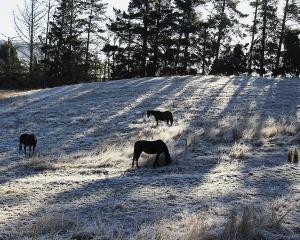It was the best of summers, it was the worst of summers. It was the season for beach and barbecue. It was the time when dreaded drought stretched its grip across the country.
Summer breeze made us feel fine. It ''blew the jasmine through our minds''.
One after another, through much of January and all of February, highs stalled over Aotearoa. Day after day, the sun shone and the long white, let alone the black, cloud was nowhere to be seen. Let's revel in the warmth and the memories of T-shirts and shorts, of cool refreshments and sheltering in the shade. Let's, especially those of us on the variable south-eastern coast, appreciate a summer to remember.
It is little wonder that visitors have been blown away by beauty set against a blue backdrop. It is not surprising that someone like former cricketing star Sir Ian Botham could come to Queenstown for the golf and say that this could easily be his home.
December was a mixed month, with regular rain boosting soil moisture. Between Christmas and New Year was windy, especially in the lakeside holiday spots of Central Otago, and there was West Coast flooding.
The lakes filled and the hydro dams spilled. Early January then saw further heavy rain, as well as sunshine, and grass grew and gardens flourished. In the South, there followed a January dry run, one decent rain early in February and then three weeks with next to no precipitation. Dunedin had its fifth-highest sunshine figures for February on record.
At least, we began our arid spell from a soft soil base, and it wasn't too hot. Further north, the situation has become grim. A drought has been declared in Northland and Auckland, and Waikato, still the heart of this country's dairy output, looks like being next. The east coasts of both islands have steadily become more and more parched as sun-kissed green has become sun-burnt brown.
Auckland, the city of the downpours, has become the city of sunbeams. Humidity, too, has been low there, with light winds from the south. Such have been the conditions that the residents of our main centre cannot quite believe what they are experiencing.
New Zealand is blessed with a temperate climate that is, usually, just right - not too hot and not too cold and, usually, not too dry and not too wet. This underpins agricultural production in our green and pleasant land. Unfortunately, the grass doesn't grow when the land becomes seared, and it is not just farmers who suffer. Economists have begun ringing alarm bells. The way the summer and beyond is heading, the parched paddocks could cost us $1 billion or more in desperately needed export earnings. Why? Because dairy farming and water go together like milk and cereal and New Zealand has become ever more dependent on the butterfat of the land. Fortunately, prices, even with the high New Zealand dollar, are holding up.
As the economy wobbles along and manufacturing stutters, the last thing New Zealand needs is spreading drought to force more dairy farmers into costly supplementary feeding, less frequent milking and drying off of herds. Autumn began yesterday a little cooler and a little cloudier, and light rain on occasions seem possible this coming week. But a steady drenching is desperately needed soon, especially in the north. Meanwhile, in the South, as leaves begin to turn and tumble, ground temperatures will start to fall significantly and an autumn flush will become less achievable.
Ironically, the meat processing industry is receiving a lift as farmers shed mouths to feed. Of course, though, this is a short-term boost that presages medium-term problems.
Niwa's predictions for autumn are for further above-average temperatures and near-normal rainfall, which could well be insufficient to revive pastures sufficiently. But regular reminders through March, April and May of our long, warm summers will be welcome for most.
And then will come winter. And as American John Steinbeck once wrote: ''What good is the warmth of summer, without the cold of winter to give it sweetness''







